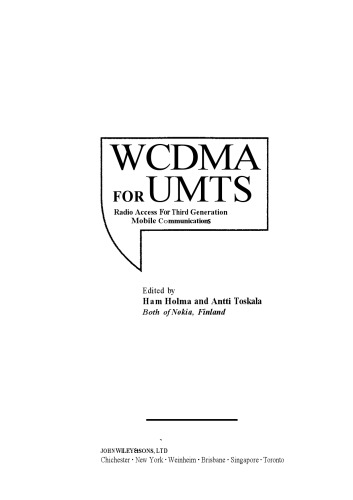

Most ebook files are in PDF format, so you can easily read them using various software such as Foxit Reader or directly on the Google Chrome browser.
Some ebook files are released by publishers in other formats such as .awz, .mobi, .epub, .fb2, etc. You may need to install specific software to read these formats on mobile/PC, such as Calibre.
Please read the tutorial at this link: https://ebookbell.com/faq
We offer FREE conversion to the popular formats you request; however, this may take some time. Therefore, right after payment, please email us, and we will try to provide the service as quickly as possible.
For some exceptional file formats or broken links (if any), please refrain from opening any disputes. Instead, email us first, and we will try to assist within a maximum of 6 hours.
EbookBell Team

5.0
58 reviews
ISBN 10: 0470844671
ISBN 13: 9780470844670
Author: Harri Holma
1. Introduction
1.1 WCDMA Early Phase
1.2 HSPA Introduction and Data Growth
1.3 HSPA Deployments Globally
1.4 HSPA Evolution
1.5 HSPA Network Product
1.6 HSPA Future Outlook
2. UMTS Services
2.1 Introduction
2.2 Voice
2.3 Video Telephony
2.4 Messaging
2.5 Mobile Email
2.6 Browsing
2.7 Application and Content Downloading
2.8 Streaming
2.9 Gaming
2.10 Mobile Broadband for Laptop and Netbook Connectivity
2.11 Social Networking
2.12 Mobile TV
2.13 Location-Based Services
2.14 Machine-to-Machine Communications
2.15 Quality of Service (QoS) Differentiation
2.16 Maximum Air Interface Capacity
2.17 Terminals
2.18 Tariff Schemes
3. Introduction to WCDMA
3.1 Introduction
3.2 Summary of the Main Parameters in WCDMA
3.3 Spreading and Despreading
3.4 Multipath Radio Channels and Rake Reception
3.5 Power Control
3.6 Softer and Soft Handovers
4. Background and Standardization of WCDMA
4.1 Introduction
4.2 Background in Europe
4.3 Background in Japan
4.4 Background in Korea
4.5 Background in the United States
4.6 Creation of 3GPP
4.7 How Does 3GPP Operate?
4.8 Creation of 3GPP2
4.9 Harmonization Phase
4.10 IMT-2000 Process in ITU
4.11 Beyond 3GPP Release 99 WCDMA
4.12 Industry Convergence with LTE and LTE-Advanced
5. Radio Access Network Architecture
5.1 Introduction
5.2 UTRAN Architecture
5.3 General Protocol Model for UTRAN Terrestrial Interfaces
5.4 Iu, the UTRAN–CN Interface
5.5 UTRAN Internal Interfaces
5.6 UTRAN Enhancements and Evolution
5.7 UMTS CN Architecture and Evolution
6. Physical Layer
6.1 Introduction
6.2 Transport Channels and Their Mapping to the Physical Channels
6.3 Spreading and Modulation
6.4 User Data Transmission
6.5 Signaling
6.6 Physical Layer Procedures
6.7 Terminal Radio Access Capabilities
6.8 Conclusion
7. Radio Interface Protocols
7.1 Introduction
7.2 Protocol Architecture
7.3 The Medium Access Control Protocol
7.4 The Radio Link Control Protocol
7.5 The Packet Data Convergence Protocol
7.6 The Broadcast/Multicast Control Protocol
7.7 Multimedia Broadcast Multicast Service
7.8 The Radio Resource Control Protocol
7.9 Early UE Handling Principles
7.10 Improvements for Call Set-up Time Reduction
8. Radio Network Planning
8.1 Introduction
8.2 Dimensioning
8.3 Capacity and Coverage Planning and Optimization
8.4 GSM Co-planning
8.5 Inter-Operator Interference
8.6 WCDMA Frequency Variants
8.7 UMTS Refarming to GSM Band
8.8 Interference between GSM and UMTS
8.9 Remaining GSM Voice Capacity
8.10 Shared Site Solutions with GSM and UMTS
8.11 Interworking of UMTS900 and UMTS2100
9. Radio Resource Management
9.1 Introduction
9.2 Power Control
9.3 Handovers
9.4 Measurement of Air Interface Load
9.5 Admission Control
9.6 Load Control (Congestion Control)
10. Packet Scheduling
10.1 Introduction
10.2 Transmission Control Protocol (TCP)
10.3 Round Trip Time
10.4 User-Specific Packet Scheduling
10.5 Cell-Specific Packet Scheduling
10.6 Packet Data System Performance
10.7 Packet Data Application Performance
11. Physical Layer Performance
11.1 Introduction
11.2 Cell Coverage
11.3 Downlink Cell Capacity
11.4 Capacity Trials
11.5 3GPP Performance Requirements
11.6 Performance Enhancements
12. High-Speed Downlink Packet Access
12.1 Introduction
12.2 Release 99 WCDMA Downlink Packet Data Capabilities
12.3 The HSDPA Concept
12.4 HSDPA Impact on Radio Access Network Architecture
12.5 Release 4 HSDPA Feasibility Study Phase
12.6 HSDPA Physical Layer Structure
12.7 HSDPA Terminal Capability and Achievable Data Rates
12.8 Mobility with HSDPA
12.9 HSDPA Performance
12.10 HSPA Link Budget
12.11 HSDPA Iub Dimensioning
12.12 HSPA Round Trip Time
12.13 Terminal Receiver Aspects
12.14 Evolution in Release 6
12.15 Conclusion
13. High-Speed Uplink Packet Access
13.1 Introduction
13.2 Release 99 WCDMA Downlink Packet Data Capabilities
13.3 The HSUPA Concept
13.4 HSUPA Impact on Radio Access Network Architecture
13.5 HSUPA Feasibility Study Phase
13.6 HSUPA Physical Layer Structure
13.7 E-DCH and Related Control Channels
13.8 HSUPA Physical Layer Operation Procedure
13.9 HSUPA Terminal Capability
13.10 HSUPA Performance
13.11 Conclusion
14. Multimedia Broadcast Multicast Service (MBMS)
14.1 Introduction
14.2 MBMS Impact on Network Architecture
14.3 High-Level MBMS Procedures
14.4 MBMS Radio Interface Channel Structure
14.5 MBMS Terminal Capability
14.6 MBMS Performance
14.7 MBMS Deployment and Use Cases
14.8 Benchmarking of MBMS with DVB-H
14.9 3GPP MBMS Evolution in Release 7
14.10 Why Did MBMS Fail?
14.11 Integrated Mobile Broadcast (IMB) in Release 8
14.12 Conclusion
15. HSPA Evolution
15.1 Introduction
15.2 Discontinuous Transmission and Reception (DTX/DRX)
15.3 Circuit Switched Voice on HSPA
15.4 Enhanced FACH and Enhanced RACH
15.5 Latency
15.6 Fast Dormancy
15.7 Downlink 64QAM
15.8 Downlink MIMO
15.9 Transmit Diversity (TxAA)
15.10 Uplink 16QAM
15.11 UE Categories
15.12 Layer 2 Optimization
15.13 Architecture Evolution
15.14 Conclusion
16. HSPA Multicarrier Evolution
16.1 Introduction
16.2 Multiple Access and Architecture Decisions
16.3 LTE Impact on Network Architecture
16.4 LTE Multiple Access
16.5 LTE Physical Layer Design and Parameters
16.6 LTE Physical Layer Procedures
16.7 LTE Protocols
16.8 Performance
16.9 LTE Device Categories
16.10 LTE-Advanced Outlook
16.11 Conclusion
17. TD-SCDMA
17.1 Introduction
17.2 TD-SCDMA Overview
17.3 TD-SCDMA and WCDMA Comparison
17.4 TD-SCDMA Deployment
17.5 TD-SCDMA Evolution
17.6 Conclusion
wcdma tutorial
wcdma modulation
wcdma for umts hspa evolution and lte pdf
wcdma and umts
what is wcdma
wcdma umts
Tags: Harri Holma, WCDMA, UMTS